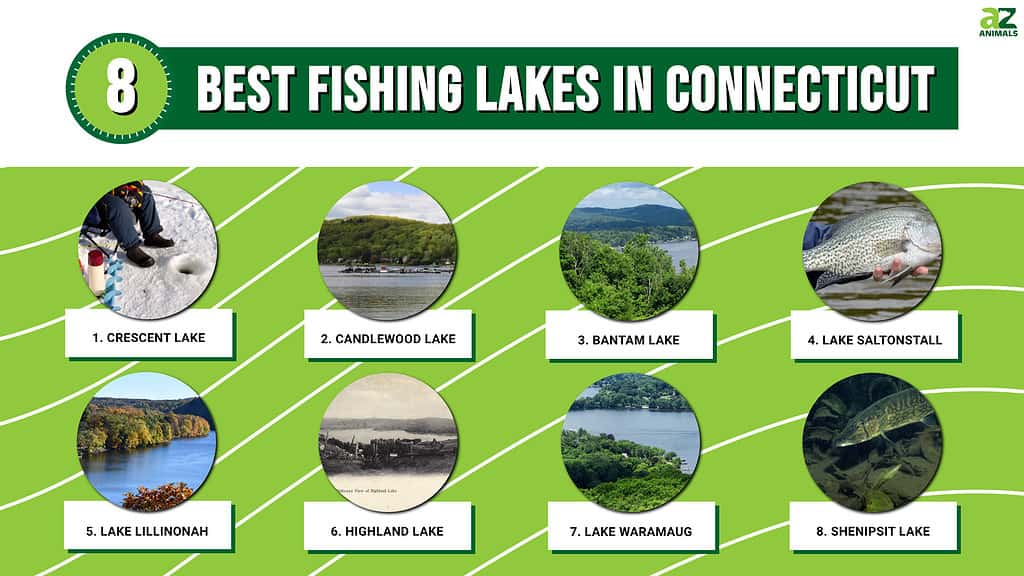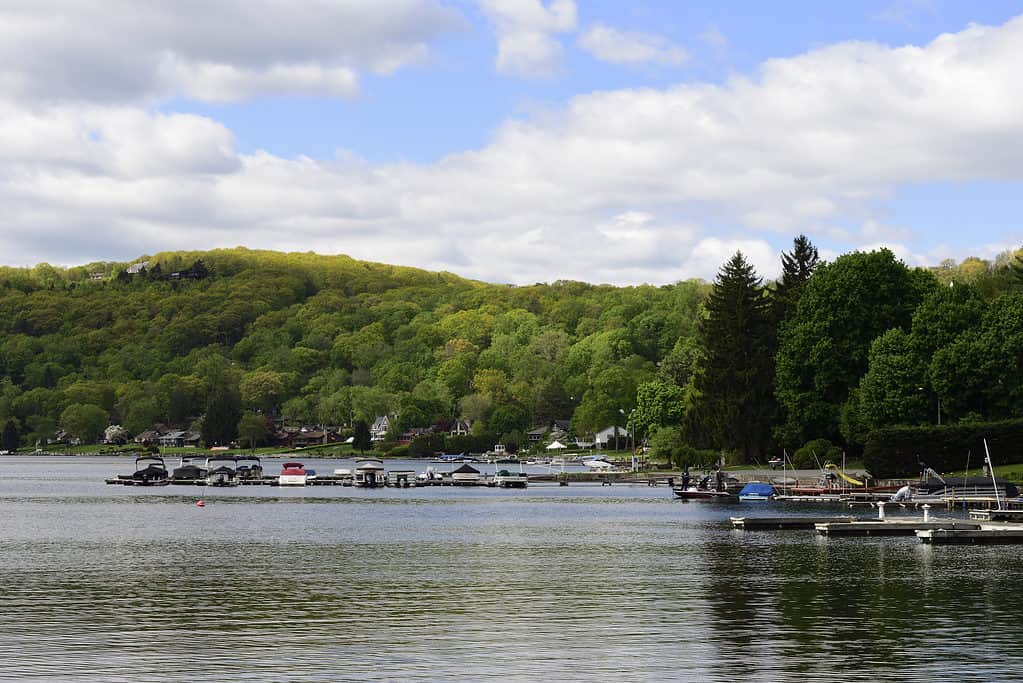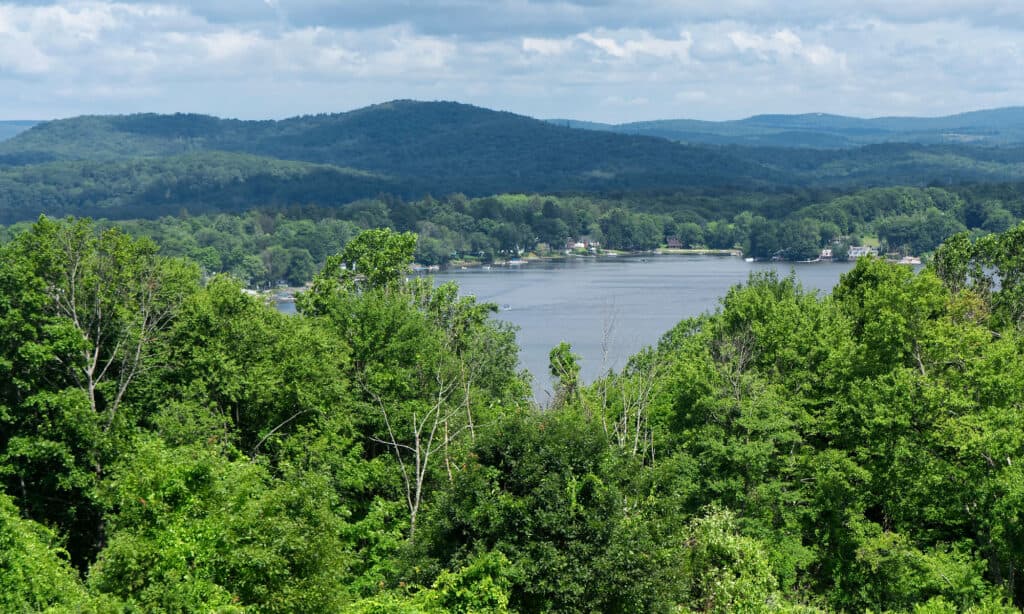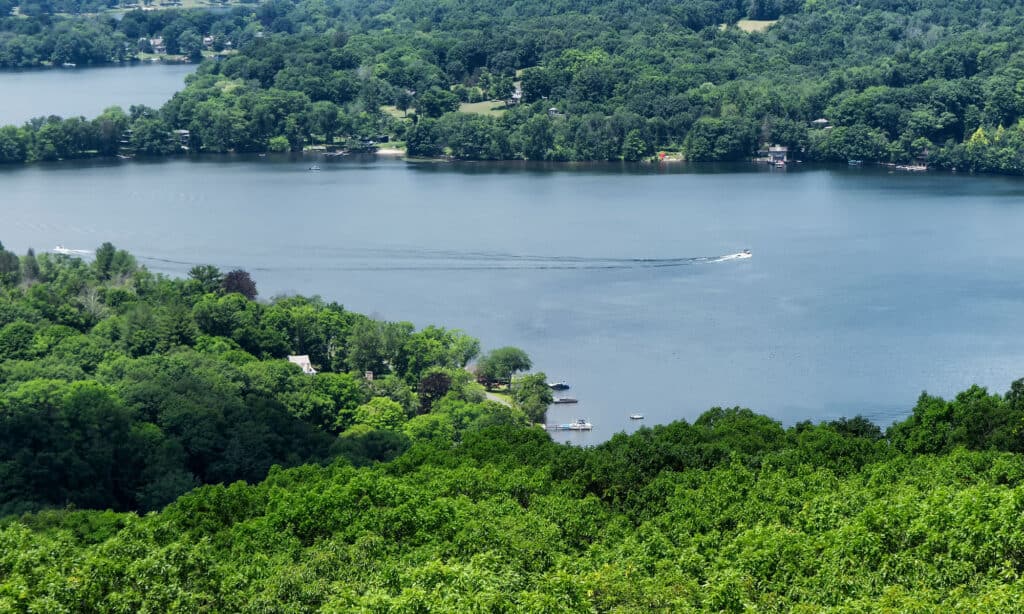
Crescent Lake offers well-maintained trails for those wishing to stretch their legs and soak in the surrounding natural beauty.
©
Nestled within the picturesque landscapes of Connecticut lie hidden treasures that lure anglers from far and wide. The lakes in Connecticut have crystal-clear waters and abundant fish populations. These bodies of water invite both seasoned anglers seeking a challenge and beginners looking to cast for the first time.
Get your fishing equipment out and join us on a journey through the best fishing lakes in Connecticut!
1. Crescent Lake

Outdoor enthusiasts have the opportunity to engage in a plethora of activities, including ice fishing during the chilly winter.
©iStock.com/gr8mgb
Crescent Lake is nestled along Shuttle Meadow Road. It is an absolute paradise for those seeking a memorable day of fishing in a breathtaking setting. Spanning an impressive 56 acres, this expansive waterbody boasts an abundance of remarkable fish species. It’s also a maintained outdoor haven.
True to its name, Crescent Lake’s land formation gracefully curves, lending it a distinct and charming appeal. Within its serene waters, anglers can expect to encounter an impressive array of fish. These range from lively small and largemouth bass to thrill-inducing threshers, amberjack, calico bass, and catfish.
With such a vast expanse to explore, having a boat at your disposal adds an extra touch of convenience. However, fear not if you prefer to venture on land. Crescent Lake offers well-maintained trails for those wishing to stretch their legs and soak in the surrounding natural beauty.
A boating and fishing license is required to fully enjoy the wonders of Crescent Lake. These requirements assure visitors of the commitment to preserving ecological balance and ensuring a worthwhile experience.
Outdoor enthusiasts have the opportunity to engage in a plethora of activities that cater to their adventurous spirit. These include boating adventures, canoeing and kayaking, and even experiencing ice fishing during the chilly winter.
Connecticut’s fishing regulations are subject to change throughout the year. It’s always wise to stay informed and updated before embarking on your angling adventure at Crescent Lake.
2. Candlewood Lake

One of the remarkable aspects of Candlewood Lake is its vast expanse. It covers over eight square miles.
©tmphoto98/Shutterstock.com
Candlewood Lake, a stunning body of water in Connecticut, holds a fascinating secret—it is actually a man-made reservoir. Back in the 1920s, the Army Corps of Engineers partnered with a local power company to construct this hydroelectric powerhouse. And their efforts were a resounding success.
One of the remarkable aspects of Candlewood Lake is its vast expanse. It covers over eight square miles and borders Litchfield County, while meeting the majestic Appalachian Mountains of Western Connecticut. Renowned as a trophy smallmouth bass lake, Candlewood also boasts impressive trophy largemouth.
Springtime marks the prime season for largemouth bass fishing as they migrate toward the warmer waters and seek shelter near structures such as docks, creek mouths, and shallow coves.
Candlewood Lake is a haven not only for bass enthusiasts but also for trout lovers. The Connecticut Department of Energy & Environmental Protection (DEEP) generously stocks the lake with brown and rainbow trout annually, with recent records showing an increased number of brown trout releases.
This remarkable fishing destination also boasts impressive panfish varieties. Crappie fishing reaches new heights here, with Connecticut’s largest recorded catch-and-release crappie stretching a remarkable 19 inches. Additionally, Candlewood Lake boasts sizeable white perch exceeding 15 inches and an abundance of yellow perch, with the latter being a favorite among ice-fishing enthusiasts.
For those eager to embark on their fishing adventures, the public boat launch at 8 Forty Acre Mountain Road in Danbury provides convenient access to the southern end of Candlewood Lake. With parking available for up to 40 vehicles and a well-maintained concrete ramp, anglers can enjoy the lake’s bountiful offerings.
3. Bantam Lake

or avid anglers, Bantam Lake presents an exceptional opportunity for game fishing, as it’s teeming with various prized catches.
©iStock.com/Daniel Hanscom
Bantam Lake, located in the western region of Connecticut, stands as the state’s largest natural lake, spanning an impressive 947 acres. This picturesque water body offers a serene escape into nature, boasting a diverse array of species and an abundance of birds.
Whether you seek tranquility or thrilling water sports, Bantam Lake is an ideal weekend trip destination. After a rewarding fishing expedition, relax at the nearby Bantam Ski Club or bask in the sun-drenched sandy beach.
For avid anglers, Bantam Lake presents an exceptional opportunity for game fishing, as it’s teeming with various prized catches. Here, you can reel in smallmouth bass, black crappie, largemouth bass, brown trout, rainbow trout, bluegill, pumpkinseed sunfish, redbreast sunfish, white perch, rock bass, yellow perch, northern pike, and chain pickerel.
Throughout the year, numerous events take place, including annual bass tournaments showcasing the lake’s thriving fishing community.
Within the heart of the lake lies its deepest holes, plunging to depths of 20-plus feet. Launching from either ramp located in the South Bay and heading northward, you’ll pass through a narrow section of the lake accentuated by a 16-foot hole. This particular area proves particularly ideal, especially as the water warms during the summer months. Furthermore, Bantam Lake is one of Connecticut’s best ice fishing spots.
4. Lake Saltonstall

Lake Saltonstall’s underwater ecosystem is home to a diverse range of species, including black crappie.
©M Huston/Shutterstock.com
Immerse yourself in the breathtaking beauty of Lake Saltonstall, a picturesque long and narrow lake nestled amidst the stunning trap rock Saltonstall Mountain in south-central Connecticut. With its enchanting surroundings of majestic mountains and lush forests, this hidden gem spans an area of approximately 1.7 square kilometers, offering a tranquil oasis for outdoor enthusiasts and fishing experts.
When it comes to exploring the lake’s pristine waters, the local water company provides convenient boat rentals, making it accessible to all visitors. Instead of relying on private boats, you can take advantage of these rentals regulated by the Regional Water Authority (RWA), which oversees the lake.
By purchasing a recreational permit from the RWA, you gain access not only to fishing but also to hiking trails and other RWA-owned properties, ensuring a delightful adventure awaits.
Lake Saltonstall boasts an impressive variety of native and stocked fish, making it a paradise for anglers. Its underwater ecosystem is home to a diverse range of species, including smallmouth bass, black crappie, walleye, trout, yellow perch, largemouth bass, and carp.
For those passionate about bass fishing, Lake Saltonstall holds a special place. It is renowned as a trophy bass management lake for its exceptional bass fishing opportunities. The carefully maintained ecosystem and regulations contribute to the growth of trophy-sized bass, making every fishing trip here a thrilling endeavor.
Whether you choose to cast your line from the shore or explore the waters by boat, you’re sure to find a prime spot for landing the catch of a lifetime.
5. Lake Lillinonah

When fall arrives, angling enthusiasts often consider Lake Lillinonah to be the ultimate destination for bass fishing in the state.
©Ritu Manoj Jethani/Shutterstock.com
Lake Lillinonah, situated in Fairfield, Litchfield, and New Haven counties of Western Connecticut, is a manmade lake renowned for its abundant recreational opportunities, including boating, kayaking, hiking, and fishing.
Located approximately 60 miles northeast of the bustling city of New York, it stands as the second largest lake in Connecticut, only overshadowed by Candlewood Lake. Covering a surface area of around 1,700 acres, this picturesque lake boasts a maximum depth of approximately 110 feet.
When fall arrives, angling enthusiasts often consider Lake Lillinonah to be the ultimate destination for bass fishing in the state. Expert anglers highly recommend this lake due to its unique characteristics.
The variety of fish species that inhabit the waters of Lake Lillinonah is truly remarkable. Anglers can expect to encounter sunfish, carp, white perch, chain pickerel, yellow perch, northern pike, brown bullhead, catfish, largemouth bass, and smallmouth bass, providing an exciting range of options to explore.
One of the notable aspects of Lake Lillinonah is its protection from urban development, thanks to the Aldo Leopold Wildlife Management Area on its northeast shore and the Upper Paugussett State Forest along its southern bank.
Access to Lake Lillinonah is readily available to the public. A public boat launch named Lake Lillinonah (Pond Brook) Boat Launch, located on a small lake arm off Hanover Road in Newtown, provides easy entry to the lake. Additionally, Lake Lillinonah Town Park offers another public launch at the upper end of the reservoir, where it meets the Housatonic River.
6. Highland Lake

This lake has a reputation as one of the top trout fishing lakes in Connecticut.
©Not known; address side of postcard states “Printed in Germany” along left edge of address side; “No. 801 Art Store Postals” printed on lower left-hand corner, picture side / This media file is in the public domain in the United States. This applies to U.S. works where the copyright has expired, often because its first publication occurred prior to January 1, 1927, and if not then due to lack of notice or renewal. – License
Highland Lake in Litchfield County covers more than 440 acres, with a maximum depth of approximately 60 feet and an average depth of 25 feet!
The remarkable feature of Highland Lake is its practice of stocking trout each spring, a favorite meal for the bass that inhabits the lake. This practice allows them to grow to sizes larger than those found in unstocked lakes, making encounters with largemouth bass pushing 6 pounds quite common.
Highland Lake is divided into three wider segments, known as bays, which are interconnected by narrower sections. The deepest area, known as Second Bay, reaches depths of over 60 feet. If you’re looking for prime fishing spots, the western shore of Second Bay and the eastern shore of Third Bay should be your focus, as they feature steep drops that rapidly descend to depths of 40 feet and beyond. These corners of the lake are especially promising during the transitional seasons.
While the trout stocking program primarily benefits the growth of the lake’s bass population, it also solidifies Highland Lake’s reputation as one of the top trout fishing lakes in Connecticut.
For convenient access to the lake, the Highland Lake Boat Launch, located on West Lake Street at the north end of the lake, serves as an ideal entry point for anglers.
7. Lake Waramaug

Beyond its pristine waters, Lake Waramaug’s shores offer a chance to witness the region’s natural beauty.
©iStock.com/Daniel Hanscom
Another gem hidden in Litchfield County, Lake Waramaug, is waiting to be discovered. Spanning 650 acres, this picturesque body of water boasts a maximum depth of approximately 40 feet. It has an average depth of around 26 feet. To preserve the ambiance, the lake imposes a 12 HP limit on motorized watercraft.
Once plagued by pollution during the mid-20th century, Lake Waramaug underwent an impressive restoration led by state officials. Their efforts exceeded all expectations, turning Waramaug into one of Connecticut’s cleanest lakes.
Beyond its pristine waters, Lake Waramaug’s shores offer a chance to witness the region’s natural beauty. Keep an eye out for bears and deer, along with majestic eagles. They can often be spotted along the shoreline, their reflections mirrored in the calm surface of the lake.
The southeastern arm of the lake is home to its deepest holes, reaching depths of approximately 40 feet. Lake Waramaug’s diverse ecosystem supports various fish species, making each angling adventure unique. From carp to sunfish, chain pickerel to trout, the possibilities are endless. Anglers can also catch catfish, northern pike, smallmouth bass, and largemouth bass.
Access to Lake Waramaug is convenient through the Lake Waramaug Boat Launch on East Shore Road (Rte. 45), located at the southeastern tip of the lake. Alternatively, visitors can enjoy bank fishing, rent canoes and kayaks, or even camp. The best place to set up camp is at the northwestern end of the lake within Lake Waramaug State Park.
8. Shenipsit Lake

Lake Shenipsit is home to a variety of fish species, including chain pickerel.
©RLS Photo/Shutterstock.com
Shenipsit Lake, commonly known as “The Snip” by locals, is a natural water storage facility. This lake is nestled in Tolland County, spanning an impressive 522.8 acres. As a source of public drinking water, it is important for anglers to adhere to specific regulations. For example, you must refrain from any direct bodily contact with the water.
While these rules may seem restrictive, they shouldn’t deter you from enjoying fishing in this picturesque lake. In fact, Shenipsit Lake boasts an impressive fishing history. It holds the state record for a seven-pound, 12-ounce smallmouth bass caught back in 1995.
Access to the lake is restricted to boats registered by the Connecticut Water Authority and Shinipsit Lake Association. They undergo a mandatory 48-hour quarantine before being allowed on the water. Although this may seem like an inconvenience, it actually works in your favor. The extra time and effort required to launch your boat here mean few anglers come to this lake. This gives you a greater chance of landing a trophy-sized catch.
If you’re looking for prime fishing spots, head to the northeastern shore of the lake. Here, you’ll find the steepest drop.
Shenipsit Lake is home to a variety of fish species, including largemouth bass, calico bass, and smallmouth bass. You’ll also come across white perch, yellow perch, and chain pickerel. With such diverse aquatic life, you’ll have plenty of options to test your angling skills.
For those who prefer fishing from the shore, designated bank fishing areas are available. They are conveniently located on Ellington and Snipsic Lake roads, both situated on the north end of the lake.
The photo featured at the top of this post is © Dmoore5556 / Creative Commons – License / Original
Thank you for reading! Have some feedback for us? Contact the AZ Animals editorial team.






